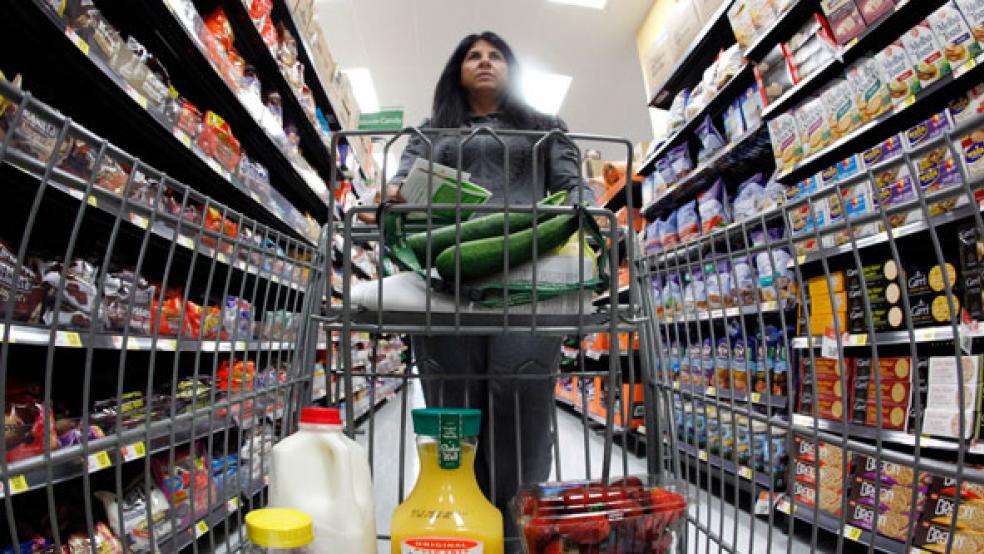With the number of overweight Americans skyrocketing, and the health care costs associated with obesity at nearly $150 billion a year, it’s hard to believe that only 5 percent of the $18 billion in farm subsidies the government spent in 2010 went to fruit and vegetables. Corn and soy – key ingredients for processed foods and fatty proteins – got the lion's share with 42 percent.
Tracie McMillan, author of the new book, The American Way of Eating: Undercover at Walmart, Applebee’s, Farm Fields and the Dinner Table, wanted to explore the true cost of food in America and follow every step of the process before it reaches our plates.
For nearly a year, McMillan, a former editor at City Limits, went undercover, working alongside Mexican garlic crews, produce managers at Walmart – the nation’s largest supplier of food – and Caribbean line cooks at Applebee’s to learn about America’s food system. The Fiscal Times talked with her about what Americans eat, why Walmart is becoming too big to fail, and what not to eat at Applebee’s.
RELATED: 7 Grocery Store Items Americans are Blowing Money On
The Fiscal Times (TFT): President Obama has proposed slashing agriculture subsidies by $32 billion over the next decade. What will this do to America’s food system?
Tracie McMillan (TM): If you wanted every American to eat a balanced diet according to nutritional guidelines, the American food supply contains only about half the fruits and vegetables required. Instead of subsidizing production, which creates all sorts of perverse incentives around growing more and more food whether or not there’s a demand for it, we should look at subsidizing demand.
It’s important to have a conversation about the kinds of crops that we subsidize, because [it impacts] the kind of diet we want people to have. Most Americans can agree that we don’t want all Americans to eat corn and soy, so we should talk about how we can shift those subsidies in order to have more fruits and vegetables.
TFT: Let’s talk about school lunches. Schools are struggling to keep costs down, while the Obama administration is pushing to have healthier options – and recently Congress declared pizza sauce a vegetable. Your thoughts on this?
TM: The school lunch discussion is important because schools are institutional buyers and you have some public control over them. Schools are an interesting bellwether for the sorts of policies we might want to pursue, in terms of making sure that food offered to kids with public money is good and healthy.
For small farmers, it makes a huge difference to have a set contract for your crop. Institutional purchasing makes farming stable. If you can change the way school lunches work, you can make it possible for smaller scale farmers to exist and thrive.
TFT: The federal food stamp program has more than doubled since the recession started and much of this is being spent on processed food. Is this the most effective use of taxpayers’ money, or is there a better way?
TM: The food stamp program is important and accomplishes a lot of great things, but I think people are buying what we make it easy for them to buy. We’ve made it really easy for people to buy junk food and processed food. If you make it easy and convenient for people to get fresh fruits and vegetables, they tend to go for it.
I’ve never met anyone who thought diabetes was awesome and was going to eat a lot of crappy food that made them sick. People don’t think like that. It’s a shame we tend to expect so little of people who don’t have much money. In my experience, they’re just as invested in eating well as people with more money. We shouldn’t be asking, “Should we let people buy junk food with taxpayer dollars?” The question we should ask is, “Should we be spending taxpayer dollars to produce more junk food?”
TFT: Even if we can afford healthy fresh foods, with more and more families depending on a two-person income and experiencing hectic work schedules, will we ever be able to could cook healthy meals at home?
TM: In order to do more home cooking, we’d have to [repair] our life/work balance and family policies. We talk a lot about how the French have this wonderful food culture, but the French also have five weeks a year of vacation, free childcare after age one, and free education at university. If I had five weeks of vacation a year, I would be interested in canning all my vegetables. I can’t do that right now.
TFT: What secrets did you uncover while working at Walmart?
TM: Walmart’s notoriously secretive, but I got one of their inventory sheets from a shipment, so I know what their price margins are. Walmart has an insane advantage because it’s so large. A traditional supermarket has 50,000-60,000 items, while a Walmart supercenter has 135,000. If you have additional 80-90,000 items, you can price 30,000 items at little to no profit.
There are 29 metropolitan areas where Walmart controls 50 percent or more of the grocery market, and [overall] Walmart controls about 22 to 24 percent of food retail in the U.S., which is the biggest share of any food retailer in history and bigger than the next three retailers combined. And when consolidation happens in marketplaces, prices tend to rise.
I don’t trust a company to not raise its prices if it has the ability to. Walmart is publicly traded; there’s no reason for it to keep charging us low prices if it’s gotten rid of the competition. The idea that we’re encouraging Walmart to enter underserved communities and further expand gives it a level of power over our food supply that I’m uncomfortable with. I’m for produce in our communities, but when a company controls 25-30 percent of an industry, it becomes too big to fail. It’s one thing when you’re making cars; it’s another thing when it’s your food supply.
TFT: How about your time at Applebee’s? Learn anything interesting about how they’re using food?
TM: I didn’t get any formal food safety training and no one there seemed like they had any formal food safety training. Cooks would give me a tray of mashed potatoes that were two days over their expiration date and they’d ask me to reheat them so they could use them. I would turn to the guy training me and ask, “Isn’t that gross?” and he said, “You’re going to see a lot of things here.”
Also, the portioning for the sides is done in advance. So the broccoli comes in precut florets. You dump those into a big tub and then make this gelatinous Italian dressing and put it into bags. Then you put the broccoli in the microwave, and it steams in the bag. You don’t take the broccoli out of the bag until just before it goes out, because it will start congealing and looking weird, so my job as an expediter was to dump it on the plate. The plastic is flaking over everything because it’s been subjected to this heat. So you’re sending out these sides that have little flakes of plastic stuck on them. If I were a diner, I would think that it was salt.
TFT: Will you ever eat at Applebee’s again?
TM: Yeah, but I stick with things that come off the grill. Burgers, steaks and fish are industrial meat and are defrosted and cooked, and generally speaking, I can tell if the meat isn’t cooked. And I have to say, their fries are pretty good.




